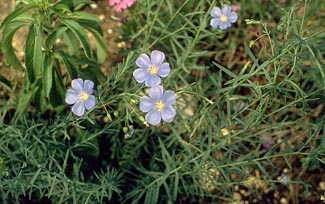Lewis Flax

Common Name(s):
Lewis Flax
Blue Flax
Prairie Flax
Western Blue Flax
Scientific Name:
Linum lewisii Pursh.
Scientific Name Synonyms:
None Known
Symbol:
LILE3
Description:
Life Span: Perennial
Origin: Native
Growth Characteristics: Lewis flax is an annual or short-lived perennial, semi-evergreen forb. It sometimes has a semi-woody base. Growth of flax begins in early spring and flowers appear in mid May through July. It grows 2-3 feet tall and 1 foot wide. The leaves grow to about 18 inches up the plant. Lewis flax reproduces by seed.
Flowers: Attractive, delicate flowers, striking blue in color, appear at the end of nodding stalks. Flowers are perfect and borne in racemes or cymes and are 2 inches wide. The sepals, petals, stigmas and stamens are in multiples of five. There are 10 seeds. Flowers close each evening and open again in the morning.
Fruits/Seeds: Fruit is a capsule, seeds are mucilaginous (slimy) when wet.
Leaves: Many narrow, small, alternate (rarely opposite) leaves that are sessile (lacking stocks) on the stems. Leaves are long (up to 1 inch) and gray-green in color. 1-nerved, pointed to rounded, slightly smaller upwards on the stem.
Stems: Many delicate, wiry stems.
Roots: Long taproot.
Ecological Adaptions:
Lewis flax has excellent cold winter and drought tolerance. It is usually found in open areas, but it will tolerate semi-shade. Plants are fire resistant due to the leaves and stems staying green with relatively high moisture contents during most of the fire season. It prefers dry, open places.
Soils: Does best on well-drained soils. It will tolerate weakly saline to weakly acidic soil.
Associated Species: Big sagebrush, pinyon pine, crested wheatgrass
Uses and Management:
Lewis Flax is named for Captain Meriwether Lewis of the famed Lewis and Clark expedition.
Lewis Flax has fair forage for both livestock and wildlife during spring and winter. Birds use the seeds and capsules in fall and winter.
When seeding Lewis Flax, the best seeding results are obtained from seeding in late fall to very early spring on heavy to medium textured soils, and in late fall on medium to light textured soils. Late summer seeding is not recommended.
The seeds of Lewis flax are edible cooked. They have a pleasant nutty taste and are very nutritious. The seed has high oil content and can be eaten on its own or used as a flavoring. It should not be eaten raw because it contains cyanide, but this is destroyed in the cooking process.
The plant is anti-rheumatic, and has agents that relieve and remove gas from the digestive system, and contains substances which give strength and tone the stomach. The oil in the seed has soothing and lubricating properties and is used in medicines to soothe tonsillitis, sore throats, coughs, colds, constipation, grave and stones. When mixed which an equal quantity of lime water it is used to treat burns and scalds. A poultice of fresh crushed leaves has been used to treat eye problems. A tincture of the entire plant is used in the treatment of diarrhea. The fresh herb is boiled and taken internally for the treatment of rheumatic pains, heartburn, colds, coughs and dropsy. A poultice of the plant is applied to bruises to reduce the swelling. The seeds have agents that soften and soothe the skin when applied locally. An eye medicine is made from the seeds. An infusion of the roots is used as eyewash.
A drying oil is obtained from the seed. Used mainly for lighting, though is could also be used in all the ways that linseed oil is used – in paints, varnishes, etc. An infusion of the whole plant is used as a hair and skin wash. It is said to be very beneficial to the skin and also to help prevent hair loss. A good fiber is obtained from the stem which is used from making cloth, nets, string, baskets, mats, etc. and in paper making. When used for paper making, the stems are harvested in late summer or autumn when they are two thirds yellow and are then retted. The fiber is then stripped from the stem, cooked for two hours with lye and then beaten in a Hollander beater.

